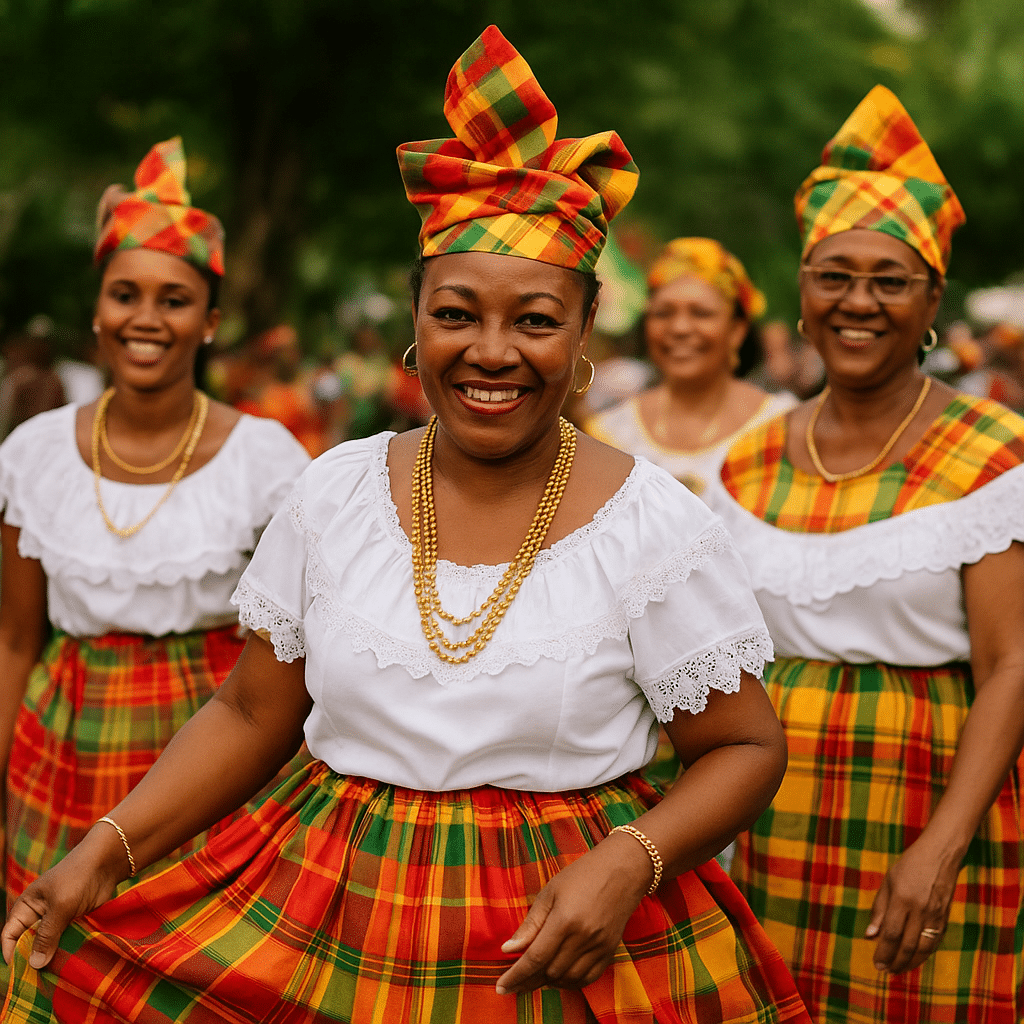
Village feasts in Dominica are more than food, music, and community, they are a vibrant stage for Creole dress and traditions. From the iconic wob dwiyet to the lively rhythms of bèlè drums, these celebrations weave together faith, fashion, and heritage into a living cultural experience.
The Story of Madras

At the heart of Creole dress is the madras fabric; brightly colored plaid cotton with roots far from the Caribbean. The name comes from Madras (now Chennai), India, where the fabric was first woven and traded during the colonial era. Shipped across the world by French and British traders, madras was adopted in the Caribbean as an affordable yet distinctive cloth.
Over time, Dominicans transformed this imported fabric into a symbol of identity. The bold reds, greens, and yellows of madras became synonymous with Creole heritage, and today it remains central to traditional attire, especially during village feasts and Independence celebrations.
Quick Poll: Which madras combo matches YOUR style?
- Red & Gold → Bold, fiery, life of the party
- Green & Yellow → Fresh, natural, easy-going
- Blue & White → Cool, calm, and classic
- Multi-Color Mix → Adventurous, creative, can’t be boxed in
The Wob Dwiyet: National Dress
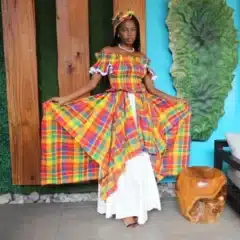
The wob dwiyet is Dominica’s national dress. A graceful gown with a full skirt, fitted bodice, lace details, and often a train. It blends European influences with Caribbean creativity. Worn with pride by women at village feasts, Creole Day and Independence parades, the wob dwiyet is both an elegant and symbolic representation of resilience, adaptation and cultural pride.
Men traditionally wear white shirts with madras sashes or waistcoats complementing the women’s attire. Children are often dressed in miniature versions keeping the tradition alive across generations.
The Tête Cassée: Creole Headwrap
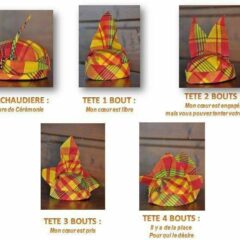
Perhaps the most expressive element of the Creole dress is the tête cassée, which is the folded madras headwrap. Far from being just decoration, each fold or “peak” of the headwrap carries a hidden meaning, a kind of cultural code passed down through generations:
- 1 Point: I am single.
- 2 Points: I am married.
- 3 Points: I am widowed or divorced.
- 4 Points: I am available / looking for a partner.
During feasts, you’ll often see women tying their head wraps with care, choosing how many points to display. It’s a tradition that adds playfulness, symbolism, and subtle communication to Creole culture.
Quick Poll: Which tête cassée style would YOU rock at a feast?
- 1 Point → Single & shining
- 2 Points → Married & glowing
- 3 Points → Strong, widowed/divorced, living your truth
- 4 Points → Available & ready to mingle
Men in Dominica also wear their heritage proudly during village feasts and cultural events. Their traditional outfit is striking in its simplicity and symbolism:
- Signature Look: A crisp white shirt, black trousers, and a bold red sash tied at the waist. This combination reflects strength, unity, and respect for tradition.
- Madras Accents: While the red sash is iconic, men sometimes add madras details as a scarf, waistband, or hat band to echo the fabric worn by women and tie their look into the wider Creole tradition.
- Accessories: A straw hat or cap, often decorated with a strip of madras, adds character and a festive touch.
- Dance & Performance: In bèlè and quadrille dances, this outfit complements the women’s wob dwiyèt creating a harmonious visual contrast of bright skirts and bold sashes.
- Modern Variations: Today, some men incorporate madras in shirts, vests, or jackets, blending contemporary fashion with the timeless red sash look.
Traditions on Display at Feasts
Village feasts showcase Creole attire at its finest:
- During La Salette Feast in Pointe Michel, villagers process through candlelit streets in cultural outfits that echo centuries of tradition.
- In Grand Bay, the pulsating Fête Isidore brings dancers in madras twirling to the beat of drums.
- Even in smaller feasts, women wear bright skirts, men sport madras sashes, and children proudly display headwraps or mini wob dwiyets.
Music, Dance & Food: The Full Creole Experience
Dominica’s traditions come alive through a vibrant mix of music, dance, and food, each element reflecting the island’s African and European heritage.
Traditional Music
- Jing Ping: The classic sound of Dominica, played with accordion, boom pipe, syak (scraper), and tambour. Jing Ping accompanies dances like the Quadrille and Mazouk, giving them their lively, syncopated rhythms.
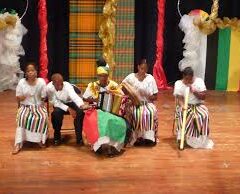
Jing Ping band - Tambour & Bèlè songs: Central to the Bèlè dance, the tambour (a goatskin drum) drives call-and-response singing between lead vocalists and the chorus. The mix of drum, chant, and footwork is as spiritual as it is festive.
- Cadence-lypso & Bouyon: Modern genres born in Dominica. Cadence-lypso (1970s) with deep Creole lyrics, and bouyon (1980s, from WCK band) with infectious energy, now dominate Independence season and Creole Day celebrations.
Traditional Dances
- Bèlè: Originating from fertility festivals, performed to tambour beats and songs. Expressive, storytelling, and community-centred.
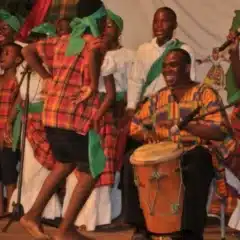
Bèlè - Quadrille: A formal French-origin square dance, danced in “four figures,” especially during Independence celebrations.
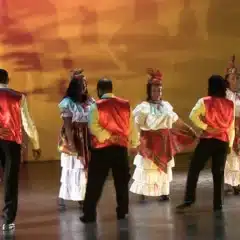
Quadrille - Mazouk: Partner dance with elegant glides and intricate footwork, usually set to Jing Ping.
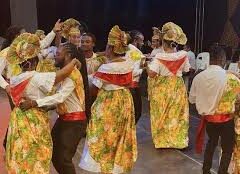
Mazouk - Sotis: A heritage-rich partner dance symbolizing African-European cultural fusion.
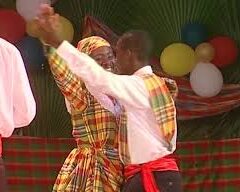
Sotis - Lancers: Group partner dance highlighting structure and unity.
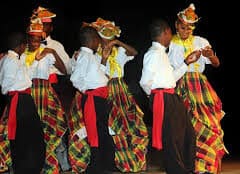
Lancers - Flirtation: Playful circular dances with five variations, emphasizing interaction and joy.
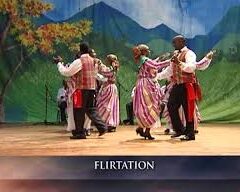
Flirtation - Other dances: Polka, Schottische, and Cotillion add depth to the repertoire, blending European style with Dominican flair.
Creole Foods
No celebration is complete without traditional Dominican cuisine:
- Callaloo soup: A hearty dish made with dasheen leaves, coconut milk, and crab or salted meats.
- Titiwi fritters: Tiny freshwater fish fried into crispy delights, especially at the Titiwi Festival in Layou.
- Bakes & saltfish: A staple Creole breakfast, also enjoyed during village feasts.
- Roasted pork & stews: Featured at Bagatelle’s Pork Festival and in many fête cook-ups.
- Cocoa tea & cassava bread: Traditional fare that connects celebrations to ancestral roots.
Together, music, dance, and food transform village feasts, Independence events, and Creole Heritage Month into unforgettable cultural experiences. The drumbeat calls, the dancers move, and the aromas of Creole kitchens remind everyone — in Dominica, celebration is a full-body, full-soul tradition.
Creole Events Around Jounen Kwéyòl
As Creole Heritage Month builds toward Jounen Kwéyòl (International Creole Day celebrated on the last Friday of October), Dominica bursts with cultural events where madras, wob dwiyet, and tête cassée are proudly on display. These celebrations highlight music, food, storytelling, and community spirit.
- Creole Heritage Month Launch (mid–late September): Each year, Dominica officially opens Creole Month with a cultural showcase often featuring the legendary Midnight Groovers alongside quadrille dancers, storytellers, and masquerade troupes.
- Community Fringe Events (September–October): Across villages and towns, you’ll find exhibitions, street markets, food fairs, and concerts that keep Creole culture alive. These smaller gatherings showcase craft, fashion, music, and traditional dishes.
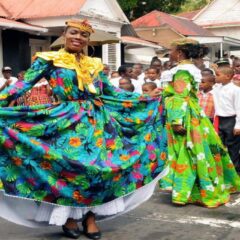
Local artisans and musicians at a Creole Heritage Month street fair in Dominica - Miss Wob Dwiyet Pageant (October): A beloved event where young women display their poise, talent, and knowledge of Creole culture while modeling the elegant wob dwiyet.
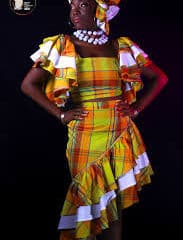
Contestant modeling the national dress during Dominica’s Miss Wob Dwiyet Pageant. - Madame Wob Dwiyet Pageant (October): Celebrating mature women, this pageant highlights elegance, wisdom, and cultural pride, with contestants presenting stunning wob dwiyet outfits.
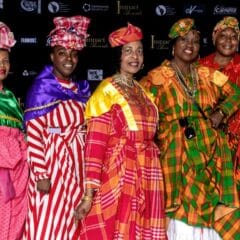
Contestants in vibrant wob dwiyet gowns at a Dominica’s Madame Wob Dwiyet Pageant - Ti Matador Pageant (October): A children’s showcase where girls step proudly in Creole dress, perform songs, dances, and skits — keeping tradition alive in the next generation.
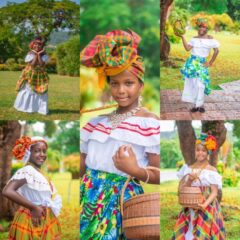
2023 Ti Matador contestants (Photo credit Ti Matador Creole Pageant FB page) - Jounen Kwéyòl (last Friday of October): The highlight of the season, when schools, businesses, and villages across the island celebrate Creole identity. Expect everyone in madras, traditional foods like titiwi fritters and bakes, and cultural programs throughout the day
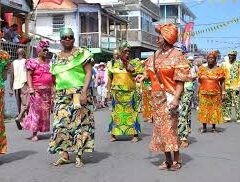
Jounen Kwéyòl celebrated in the streets in Dominica - World Creole Music Festival (final weekend of October): Known as the “three nights of pulsating rhythms,” this festival is Dominica’s biggest music event. Local and international artists take the stage, blending genres like bouyon, cadence-lypso, reggae, soca, and zouk. Beyond the music, the festival brings food stalls, artisan vendors, and thousands of fans filling the stadium in Roseau. It’s more than a concert — it’s a cultural highlight of the year.
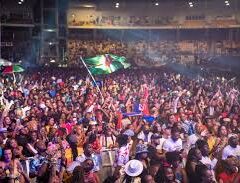
Stage lights and crowds at Dominica’s World Creole Music Festival, with fans waving flags and enjoying live performances - Cultural Gala (November 3 – Independence Day): The grand finale of the Independence season. This national showcase brings together Dominica’s best in dance, music, theater, and fashion, from bèlè and quadrille to modern Creole fusion — a fitting climax to weeks of cultural pride.
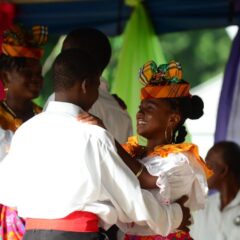
Performance at the National Cultural Gala 2011
Passing Traditions to the Next Generation
These traditions are not fading; they are alive and evolving. Schools and cultural groups teach the importance of Creole dress, and every Independence season children proudly don madras at parades. For Dominicans abroad, returning for a feast means reconnecting with identity, often through wearing or gifting Creole attire.
The Kalinago Territory also contributes its own traditions, from herbal crafts to canoe racing, showing how diverse cultures blend within Dominican feasts.
Experiencing It as a Visitor
For travellers, a village feast is one of the best opportunities to experience Creole dress first-hand. You’ll see entire families dressed in madras, local dance troupes performing in wob dwiyet, and parades filled with color.
Tips:
- Outfits can be bought or rented in Roseau or local craft shops.
- Ask permission before photographing close-up portraits.
- If invited, don’t hesitate to try on a madras sash or head-wrap locals are proud to share.
Conclusion
Creole dress in Dominica’s village feasts is more than costume, it is heritage woven into fabric, rhythm, and taste. From the imported madras cloth turned cultural icon, to the coded folds of the tête cassée, every detail carries meaning.
If you plan your travels around a village feast, come ready to eat, dance, and admire the vibrant Creole attire that makes these festivals unforgettable.
Look to guide.dm for vehicle rentals, places to stay, looking that fresh look.

